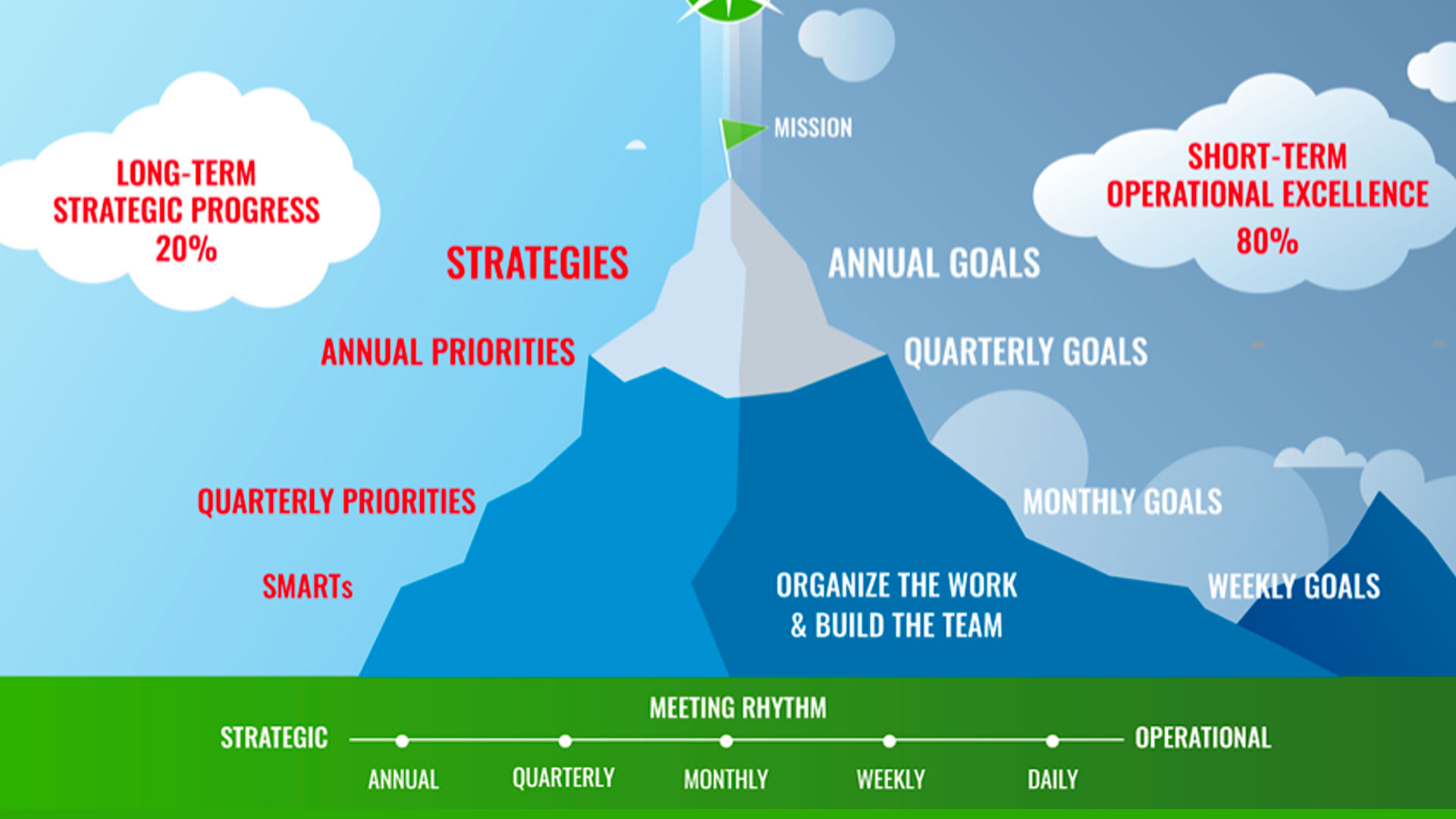
Articles
The Small Business Playbook For Annual Strategic Planning
December 10, 2020

If you haven't started already, it’s officially time to get your business ready for 2021! (And yes, we realize annual strategic planning seems unthinkable after the year we've all had. But it's also arguably never been more important!)
So if you're stuck or procrastinating, I recently chatted through all things annual planning with Growth Connect CEO Scott Fritz and Elite Entrepreneurs CEO Brett Gilliland. AKA the 2 people who've completely changed the way Trainual thinks about its future! And here are all of their top plays for facilitating planning sessions and setting goals that business can actually hit in the new year:
Align leadership first
If your business has multiple owners or partners, make sure you’re all on the same page before you even think about starting planning for next year. Scott has facilitated annual planning sessions for dozens of entrepreneurs. And he says the most common problems he runs into all happen when leaders aren’t aligned.
“I've seen eyes rolling around the table from the other executive leadership team members because they knew the owners weren't aligned.”
But defining goals and a strategy are pointless if the people at the very top don’t have one clear vision for the company. You'll end up with unclear goals, confusing messaging, and ultimately, a lot of wasted time.
Scott solves this with his “Partner Alignment Sessions,” where he interviews each owner and defines what success looks like. That way, come the annual strategic planning session, there are no objections or surprises.
Brett adds, “if you’re not anchored to a destination that you’re all going to together, it’s kind of hard to plan how to get there.”
So before coming to the table with a broader team, make sure the leadership team is aligned. Brett suggests having everyone answering the same survey. Each question, addressing the 3 foundational components of your vision: purpose, values, and mission.
And figure out a way to align any answers that differ. This doesn’t have to be in-depth, but it does need to gut check that everyone is on the same page.
🔥 Tip: Document your mission, vision, purpose, and values in Trainual. Then, assign the subject directly to all your team members to keep everyone aligned and accountable. Try for free.
Facilitate or participate - not both
According to Scott, you can’t be both a facilitator and a participant. You have to choose one. So while it’s entirely possible to run a strategy session internally. You do need to sort out any biases that your internal facilitator (AKA the employee running the session) has beforehand. Plus, make sure they understand the role and are really great at it!
Minimum, this person should have great time management skills, be able to fairly guide discussions between departments, and approach every topic with empathy. Plus, they can't be afraid to move things along if the team starts running in circles.
With that being said, playing referee is tough when you have skin in the game. So if you don’t have someone on your team with an exceptional talent for facilitation, we highly recommend using an external partner. (We do!) That way, the neutral 3rd-party can keep things moving with no agenda other than your team’s success.
Disconnect for your annual strategic planning
If there’s any time to step back from the day-to-day, it’s during your annual strategic planning session. One of the biggest mistakes you can make is hosting it onsite. That’s because fully disconnecting is impossible when you’re at the office. There are just too many distractions – and it's way too easy to get pulled away for a fire drill.
“It needs to be a 2-day retreat. And 300 miles from the office so that no one can drive back,” Scott suggests.
There also needs to be strict rules around shutting down laptops, phones, and any other devices that distract. In one of the groups I’m part of, we actually have a $100 fee for any audible notification during our meetings. It seems tough, but it also works to keep us engaged.
Of course, in 2020, things are only more complicated when these meets are happening virtually. But you can still insist on turning cellphones off, logging out of chat, and focusing solely on planning.
And the best way to do that is to lead by example. Whatever rules you set, follow them, so your team knows you’re just as invested as they are.
Get the right people in the room
The number of people at your planning session is important. Too many, and it’s difficult to make sure everyone’s voice is heard. And too few, and there's not enough nuance.
According to Scott, the perfect number is at least 4 and no more than 12. Brett agrees, saying that “6 to 8 is that sweet spot.” That way, everyone can participate in all the exercises without muddying the waters too much.
One way to keep the room lean is to curate who’s in the room and when. Not everyone will need to be present for the entire session. So invite people through the session to speak on behalf of their department or a particular issue.
Another way is to get everyone involved before you start planning. Meaning, about a week before the session, let each department run through the same exercises you’ll do with your leadership team. Then, bring those results to the annual planning session to help inform decisions.
Think bigger picture

It can be hard to get an entire team out of the day-to-day of the business – especially your leadership team. But annual strategic planning requires looking at your company as a whole. This is why your leadership team and owners need to be present.
There aren’t necessarily magic exercises that are going to spark big picture thinking. However, there are proven methods that help. For example, “a problem well defined is a problem half-solved,” says Brett. So don’t get too caught up in the how of doing this.
Instead, make sure the team is gathering all of the puzzle pieces to inform priorities. Start by having each department write down (yes, on paper) their answers to these questions:
- What are the biggest problems in the business?
- How about the biggest opportunities?
- What are competitors doing?
- Does your team have any suggestions?
I think of it like cleaning out a closet or garage. You have to get everything out and in your line of sight before you can properly organize it all. And that starts by getting all the challenges out in the open.
So by literally seeing the challenges and opportunities in front of you, you can start to categorize what comes next. And work together to turn possible threats into actionable opportunities and set priorities.
Settle on your top 3 to 5
It can feel overwhelming to decide exactly what you want to walk out of the annual planning session with. But a top priority list is the perfect way to ensure you aren’t trying to tackle too much. So, using the opportunities you've identified above, set 3 to 5 high-level priorities to keep your team aligned moving forward.
Smaller teams might thrive with just 3 priorities, where a midsize company can probably find 5 to focus on. But that said, some midsize teams can get more focused in the coming year by sticking to 3.
Label priorities with a name that sticks, something that everyone can repeat back. Then, assign each one an owner. Scott is careful to note, “ownership does not equal doership.” The owner isn’t responsible for getting all of the work done. They’re accountable for making sure the team works together to accomplish the goal.
Once an owner is assigned, work as a team to define smaller, quarterly goals that support the annual priorities. And be sure to define what a win looks like, so there’s no question when you hit the mark.
Roll out your plan company-wide
Make unveiling the year’s priorities a big deal - especially if this is the first time your team is hitting such a big milestone. So don’t just get your team aligned, but get them pumped for the things to come.
We’ve found that the best way to do this is a company-wide town hall. Set aside 2 hours for everyone to get together. And give a high-level overview of what comes next. We’ll even have priority owners stand up and walk the team through next year’s game plan.
And because this is a topic that should be more of a celebration than another boring meeting, we highly recommend giving your town hall a fun theme. Here at Trainual, our last quarterly town hall was Harry Potter themed, complete with costumes. And it’s an easy way to get people engaged in what’s being discussed - especially if it’s happening over Zoom.

🔥 Roll out a Trainual Subject that covers everything you go over in your annual strategic planning town hall. That way, everyone can stay aligned on the key priorities all of next year! Start your free trial to build a Subject.
Walk away with a reporting plan
Create a cadence for reporting back on these objectives throughout the year, so there’s no confusion when you can expect status updates. Here are 2 ways to make this happen:
1. Weekly stand-ups
“After the party is cleaned up,” says Brett, “we print everything up on cards. Each priority owner delegates who owns the actual work around these posters and physically marks off tasks that have been accomplished.” He recommends a weekly (bi-weekly max) check-in that ensures everyone is on the same page.
Another great way to do this is to use a paperless project management tool (like Asana) to make sure anyone can reference the goals at any time.
2. Monthly updates
Scott prefers a monthly cadence, where priority owners provide a status report leading up to each meeting.
Start by sharing the big wins for the priority. Then, move on to look at all the action items. You should have a few to check off - or if you’ve hit any roadblocks, a few to add. Just be sure to dive into these roadblocks offline at a later date.
“This meeting shouldn’t take more than 20 minutes,” Scott says. After closing with a word from each attendee about how they feel, move on to the next steps.
However you decide to plan for next year, it's really just important that you have a plan. That way, even if 2021 ends up feeling more like 2020, you know where you're trying to go and can pivot accordingly to make sure you get there.
Similar Blog Posts











